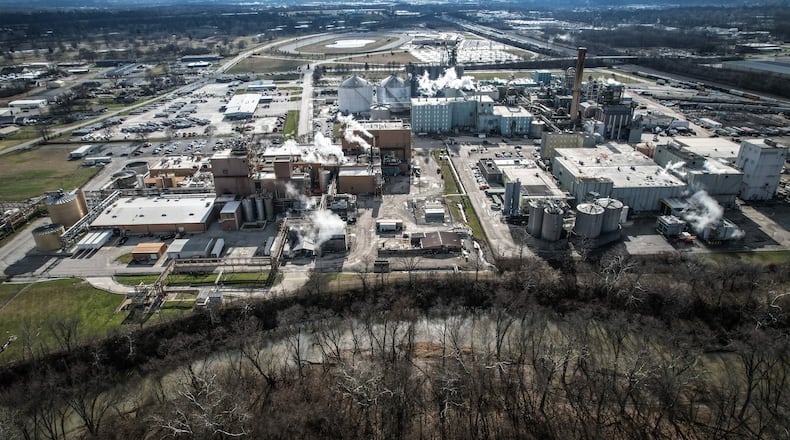Under typical circumstances, water within this system remains untouched by any raw material as it’s used as a heat control method during the milling process before being routinely discharged into the river channel adjacent to the Cargill plant, a practice that’s legal with an Ohio EPA permit.
A representative for Cargill said the incident was caused by a “mechanical malfunction” which allowed the corn byproduct to leak into the cooling system and subsequently discharge into the channel.
“The discharge was contained to the tributary, and the initial clean-up was completed immediately,” the Cargill representative said via email this week.
Cargill reported the spill to the city of Dayton and the Ohio EPA, prompting a multi-agency emergency response to determine the scope of the spill and its potential effects on the waterway, wildlife, and surrounding residents.
Ohio EPA documents show 35,000 gallons of the corn byproduct was discharged in the spill, an error that incurred Cargill a Notice of Violation from the agency.
Angela Olejnicek and her husband Peter live in a Harrison Twp. home on Wagner Ford Road that sits near the bank of the affected river channel. She said she first learned of the spill when she noticed crews from a responding clean-up company in front of her house.
“I called Cargill to find out if we’re safe or if what was spilled was safe, as from our house you can see directly into the water where the spill happened,” Olejnicek said. “Our water has been mint green for months.”
Olejnicek said she was told by a Cargill representative that the spill contained no toxic material and should pose no harm to humans or wildlife.
However, Olejnicek expressed concern that residents in the vicinity of the spill were not given explicit details about the incident or the material seen creating a sheen-like glow on the waterway, noting attempts to reach responding agencies were often not returned.
“From Oct. 27 until today, neither myself nor my husband has heard from any representative of Cargill, the EPA, or the Ohio Department of Natural Resources,” she said.
Credit: Jim Noelker
Credit: Jim Noelker
Olejnicek’s alarm only heightened when she and her husband began to notice a smell, which she described as similar to hydrogen sulfide, emanating from the water as crews continued clean up efforts.
“For the first week and a half there wasn’t any smell, but once they started aerating the water, the smell began,” she said, adding that for the past six to eight weeks, she’s felt physical symptoms that she’s thought could be connected.
“I’ve been sick for six weeks,” she said. “My eyes are burning, my nose is burning.”
In response to Olejnicek’s reported symptoms, Harrison Twp. officials contacted the Regional Air Pollution Control Agency on Jan. 5 ”due to air quality concerns in which neighbors report burning eyes, irritated throats and a film covering vehicles,” a Jan. 10 press release from the Harrison Twp. Fire Marshal states. “It is unclear currently if the air quality concerns are related to the materials spill.”
RAPCA conducted air monitoring on site that same day, according to the spill investigation report, with no abnormal readings recorded.
The report goes on to note that the sheen observed on the water was determined to be caused by “biological iron bacteria,” which are small living organisms that naturally occur in soil, shallow groundwater, and surface waters.
Credit: Jim Noelker
Credit: Jim Noelker
“Air screening was completed along the waterway, bridge, and towards areas of highly concerned citizens complaints, (and) no abnormal readings or hydrogen sulfide was detected,” the report states.
Often used as an ingredient in pet food products, corn protein meal, sometimes used synonymously with the term corn gluten meal, is a byproduct of corn processing or milling. And, according to the EPA, the product is non-toxic and not harmful to humans or animals.
“The primary concern was that it could cause low oxygen levels in the stream and kill fish,” said Ohio EPA spokesperson Dina Pierce of the investigation’s initial “emergency” designation.
After more than 10 weeks of clean-up efforts, Pierce said site conditions have improved.
“Some of the material was recovered, some moved downstream or settled into the creek sediment, and some was consumed by fish in the creek,” she said. “It’s also a positive note that the (oxygen level) never dropped too low. The aeration was also in place quickly, which helped it to have a minimal impact on wildlife.”
About the Author




